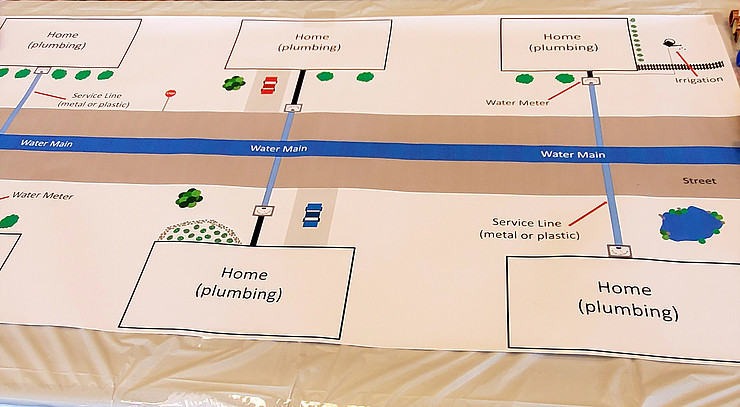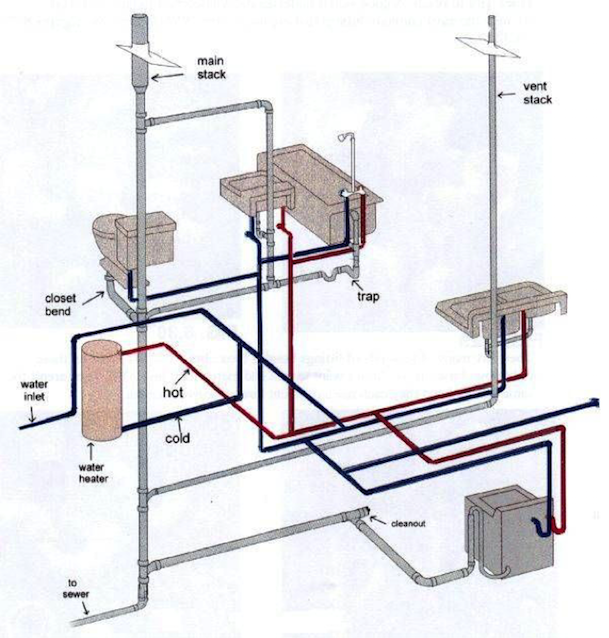Presented here further down you will discover a lot of excellent ideas when it comes to Understanding Your Home's Plumbing Anatomy.

Comprehending exactly how your home's plumbing system works is important for every home owner. From providing tidy water for drinking, cooking, and bathing to safely getting rid of wastewater, a well-kept plumbing system is critical for your family's health and comfort. In this comprehensive guide, we'll discover the intricate network that composes your home's plumbing and deal ideas on upkeep, upgrades, and dealing with usual issues.
Introduction
Your home's pipes system is more than simply a network of pipelines; it's a complicated system that guarantees you have access to clean water and effective wastewater elimination. Recognizing its parts and just how they work together can assist you stop expensive repair services and make sure whatever runs efficiently.
Fundamental Parts of a Plumbing System
Pipes and Tubing
At the heart of your pipes system are the pipelines and tubes that bring water throughout your home. These can be made of different products such as copper, PVC, or PEX, each with its advantages in terms of durability and cost-effectiveness.
Components: Sinks, Toilets, Showers, etc.
Fixtures like sinks, toilets, showers, and bath tubs are where water is made use of in your house. Comprehending exactly how these fixtures connect to the pipes system helps in diagnosing issues and planning upgrades.
Valves and Shut-off Factors
Shutoffs manage the flow of water in your pipes system. Shut-off shutoffs are important during emergencies or when you need to make fixings, allowing you to separate parts of the system without interfering with water circulation to the whole house.
Water Supply System
Key Water Line
The major water line links your home to the municipal supply of water or a private well. It's where water enters your home and is dispersed to different components.
Water Meter and Pressure Regulatory Authority
The water meter actions your water use, while a pressure regulator ensures that water moves at a risk-free pressure throughout your home's pipes system, avoiding damages to pipelines and fixtures.
Cold Water vs. Warm water Lines
Comprehending the distinction in between cold water lines, which provide water directly from the major, and hot water lines, which carry warmed water from the water heater, assists in troubleshooting and preparing for upgrades.
Drain System
Drain Pipes Pipeline and Traps
Drain pipelines carry wastewater far from sinks, showers, and toilets to the sewage system or septic tank. Catches prevent sewage system gases from entering your home and also catch particles that might cause obstructions.
Air flow Pipes
Air flow pipelines allow air right into the drain system, preventing suction that can slow down drainage and create traps to empty. Correct air flow is important for keeping the stability of your plumbing system.
Relevance of Appropriate Drainage
Making sure proper water drainage avoids back-ups and water damage. Regularly cleansing drains and keeping catches can stop expensive repairs and expand the life of your plumbing system.
Water Furnace
Types of Hot Water Heater
Water heaters can be tankless or typical tank-style. Tankless heating units warm water as needed, while storage tanks save heated water for prompt use.
Updating Your Pipes System
Reasons for Upgrading
Upgrading to water-efficient components or replacing old pipelines can enhance water quality, minimize water expenses, and increase the worth of your home.
Modern Pipes Technologies and Their Benefits
Check out technologies like smart leak detectors, water-saving commodes, and energy-efficient hot water heater that can save money and decrease ecological impact.
Expense Factors To Consider and ROI
Compute the upfront expenses versus lasting savings when thinking about pipes upgrades. Many upgrades pay for themselves via reduced utility bills and fewer repairs.
Exactly How Water Heaters Attach to the Pipes System
Understanding how water heaters attach to both the cold water supply and warm water distribution lines assists in diagnosing problems like insufficient hot water or leakages.
Upkeep Tips for Water Heaters
Routinely purging your water heater to get rid of sediment, inspecting the temperature level settings, and checking for leaks can prolong its life-span and improve energy efficiency.
Typical Plumbing Problems
Leakages and Their Causes
Leaks can happen because of maturing pipelines, loosened installations, or high water stress. Resolving leaks promptly avoids water damage and mold growth.
Blockages and Obstructions
Clogs in drains and commodes are commonly brought on by purging non-flushable products or an accumulation of oil and hair. Making use of drain screens and being mindful of what drops your drains pipes can prevent clogs.
Signs of Plumbing Problems to Look For
Low tide pressure, sluggish drains pipes, foul odors, or abnormally high water costs are indicators of potential plumbing problems that ought to be attended to quickly.
Pipes Upkeep Tips
Normal Examinations and Checks
Arrange yearly plumbing evaluations to catch problems early. Search for indications of leakages, rust, or mineral accumulation in taps and showerheads.
Do It Yourself Upkeep Tasks
Basic jobs like cleansing faucet aerators, checking for commode leakages making use of color tablet computers, or shielding revealed pipelines in cool environments can stop significant pipes problems.
When to Call an Expert Plumber
Know when a plumbing issue calls for professional proficiency. Trying complicated repair work without appropriate knowledge can lead to more damages and greater repair service expenses.
Tips for Decreasing Water Usage
Simple behaviors like dealing with leakages quickly, taking much shorter showers, and running full tons of laundry and dishes can conserve water and reduced your energy expenses.
Eco-Friendly Plumbing Options
Think about lasting pipes materials like bamboo for flooring, which is durable and eco-friendly, or recycled glass for countertops.
Emergency Preparedness
Steps to Take Throughout a Plumbing Emergency situation
Know where your shut-off valves lie and exactly how to switch off the water supply in case of a burst pipeline or significant leakage.
Importance of Having Emergency Get In Touches With Helpful
Keep call information for local plumbings or emergency solutions readily available for quick action during a pipes dilemma.
Ecological Impact and Preservation
Water-Saving Fixtures and Devices
Setting up low-flow taps, showerheads, and bathrooms can significantly minimize water usage without giving up efficiency.
DIY Emergency Fixes (When Relevant).
Short-lived repairs like using air duct tape to spot a dripping pipe or putting a bucket under a leaking tap can reduce damages till a specialist plumbing technician shows up.
Final thought.
Recognizing the composition of your home's pipes system encourages you to maintain it properly, conserving time and money on fixings. By following routine upkeep routines and remaining informed regarding contemporary plumbing technologies, you can guarantee your plumbing system runs effectively for years to find.
HOW YOUR PLUMBING SYSTEM WORKS
Which Pipes Do What?
Blue lines = fresh water supply entering the building Red lines = hot water supply entering the building Grey lines = pipes carrying waste away from the building and venting pipes carrying gases away from the building (through the roof) YOUR MAIN PLUMBING SYSTEMS
There are two main plumbing systems that support your home s basic plumbing needs one that brings clean water into your home, and one that sends dirty water away from your home. Connected to the toilet, bath, shower, and other faucets in your home, these two systems keep your water flowing in the right directions.
ACCESSING FRESH WATER
Fresh and clean water is brought into your home through the main water supply line . Filtered through one pipe, this water is pressured to flow into the various fixtures in your home at any given time.
This water can be sourced from a well located on your property, a pond or river (mostly cottages), or, as in most cases, from the city s municipal water treatment centre. However, it is important to note that water that is untreated, such as the water siphoned from ponds or rivers, may not be safe to drink. Personal water supplies always need to be treated for hardness and contaminants before consumed.
MUNICIPAL WATER SUPPLIES
Improve taste and odour Remove sediment Eliminate hardness Reduce chlorine COLD WATER SUPPLY VS. HOT WATER SUPPLY
Cold water flows into your home or building through the service line, which then distributes hot or cold water to your fixtures. This line is most commonly run through a central column that runs floor to floor. Hot water runs in short and straight pipes as the longer the pipeline, the more heat that will be lost in the transfer. Having shorter pipes also allows residents to access hot water more quickly.
WASTE WATER SYSTEM
Your wastewater system is divided into two parts pipes that send wastewater away from your home and venting pipes that send sewer gas away from your home. Sewage water travels through pipes that flush the water and waste towards local sewers that are operated and managed by your city or town. Most sewer systems rely on gravity to move the wastewater to where it needs to go.
The further away from your toilet or sink, the larger wastewater pipes become. This allows for waste to be disposed of from various parts of your home or business at once without pipe blockages. The angle and flow of these pipes are also essential for keeping your waste pipes clear of build up.
https://harrisplumbing.ca/how-your-home-plumbing-system-works/

We are very enthusiastic about Anatomy of a House: Understanding the Components and I am assuming you enjoyed reading the article. Sharing is nice. Helping people is fun. Thank you so much for taking the time to read it.
This Site